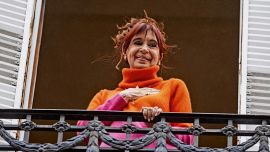Police in Argentina believe they have recovered an 18th-century painting stolen from a Dutch Jewish art collector by a Nazi official who fled to South America after World War II.
Two individuals – the daughter of high-ranking Nazi official Friedrich Kadgien and her partner – have been placed under 72-hour house arrest, accused of obstructing the investigation.
The painting, believed to be Portrait of a Lady by Italian baroque artist Giuseppe Ghislandi (also known as Fra Galgario, 1655-1743), was recognised by the Dutch newspaper AD in a photo of a house for sale in the seaside resort of Mar del Plata late last month.
But it disappeared shortly after the AD article was published.
Argentina’s federal police have been searching for the artwork. Property searches conducted Monday failed to yield the painting.
But La Plata-based newspaper El Día reported Tuesday that the artwork had been handed over, saying the family “decided to make the painting available to the civil court."
The authenticity of the artwork has not yet been confirmed, but it is believed to have been stolen from Amsterdam art dealer Jacques Goudstikker during World War II.
Goudstikker died while fleeing the Netherlands in 1940 when it was invaded by Nazi Germany, and his abandoned art collection was looted.
The for-sale notice revealed what is believed to be the Ghislandi painting in the house of Friedrich Kadgien, a financial adviser to Adolf Hitler and placed in charge of moving Nazi plunder to South America.
Kadgien died in 1978 in Argentina, where he had fled along with other Nazi war criminals.
AD – also known as Algemeen Dagblad – had tried unsuccessfully to speak to Kadgien's daughters about their father for years.
House arrest
Federal police officers were assisted by Interpol in the search for the artwork.
A daughter of Kadgien was placed under house arrest along with her husband for three days, the prosecutor in the case said Tuesday.
They will then appear in court to be charged in the painting's disappearance.
According to the La Nación newspaper, the couple insisted they are the rightful owners of the artwork, which they had inherited.
Goudstikker's heirs are determined to recover the painting, which is listed on an international registry of missing artworks.
The lawyer for Kadgien's daughter, Carlos Murias, told La Capital, a local newspaper in Mar del Plata, that the pair would cooperate with the authorities.
The prosecutor's office said investigators carrying out the search had seized two other artworks from the home of another Kadgien daughter that appeared to be from the 1800s.
"The works will be analysed to determine if they are linked to paintings stolen during World War II," it added.
Extensive collection
Goudstikker, a leading dealer of Italian and Dutch 16th- and 17th-century masters, left behind an extensive art collection of over 1,000 paintings when he fled.
Top German officials, led by Gestapo founder Hermann Göring, divided up his collection.
After the war, the Dutch state retrieved some 300 works, most of which were returned to Goudstikker's heirs.
In 2011, the Getty Museum in Los Angeles returned a 17th-century Dutch painting from Goudstikker's collection.
Many other works remain scattered around the globe.
The case has also revived questions about Argentina’s post-war role as a safe haven for Nazi fugitives.
Friedrich Kadgien, who died in Mar del Plata in 1978, was part of the extensive network that smuggled stolen assets and individuals across Europe and into South America.
His descendants’ apparent custody of the painting has prompted calls for a deeper probe into other works that may remain hidden in private collections.
Prosecutor Carlos Martínez has placed a secrecy order over the case while investigators continue to examine evidence seized in the raids.
– TIMES/AFP/NA

























Comments